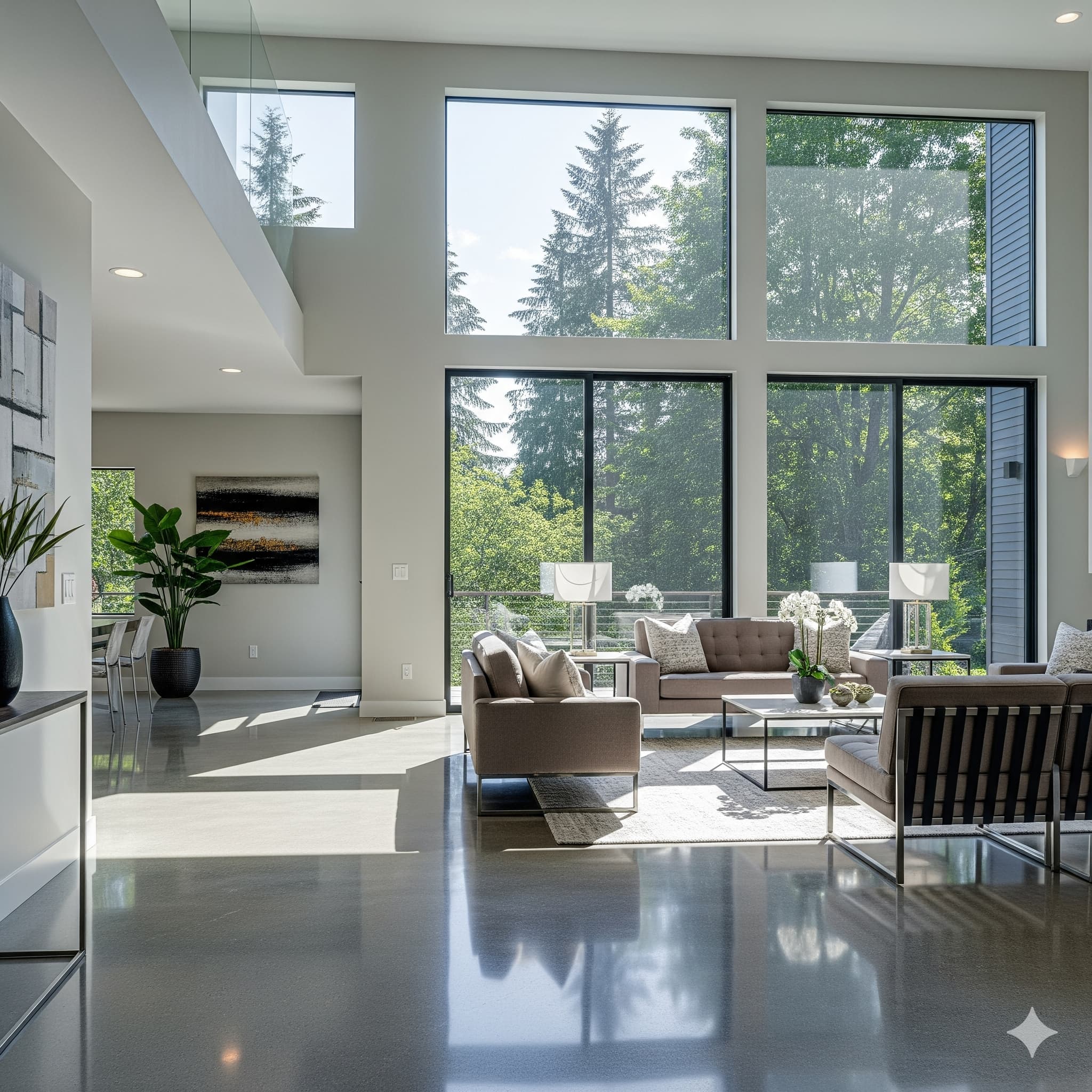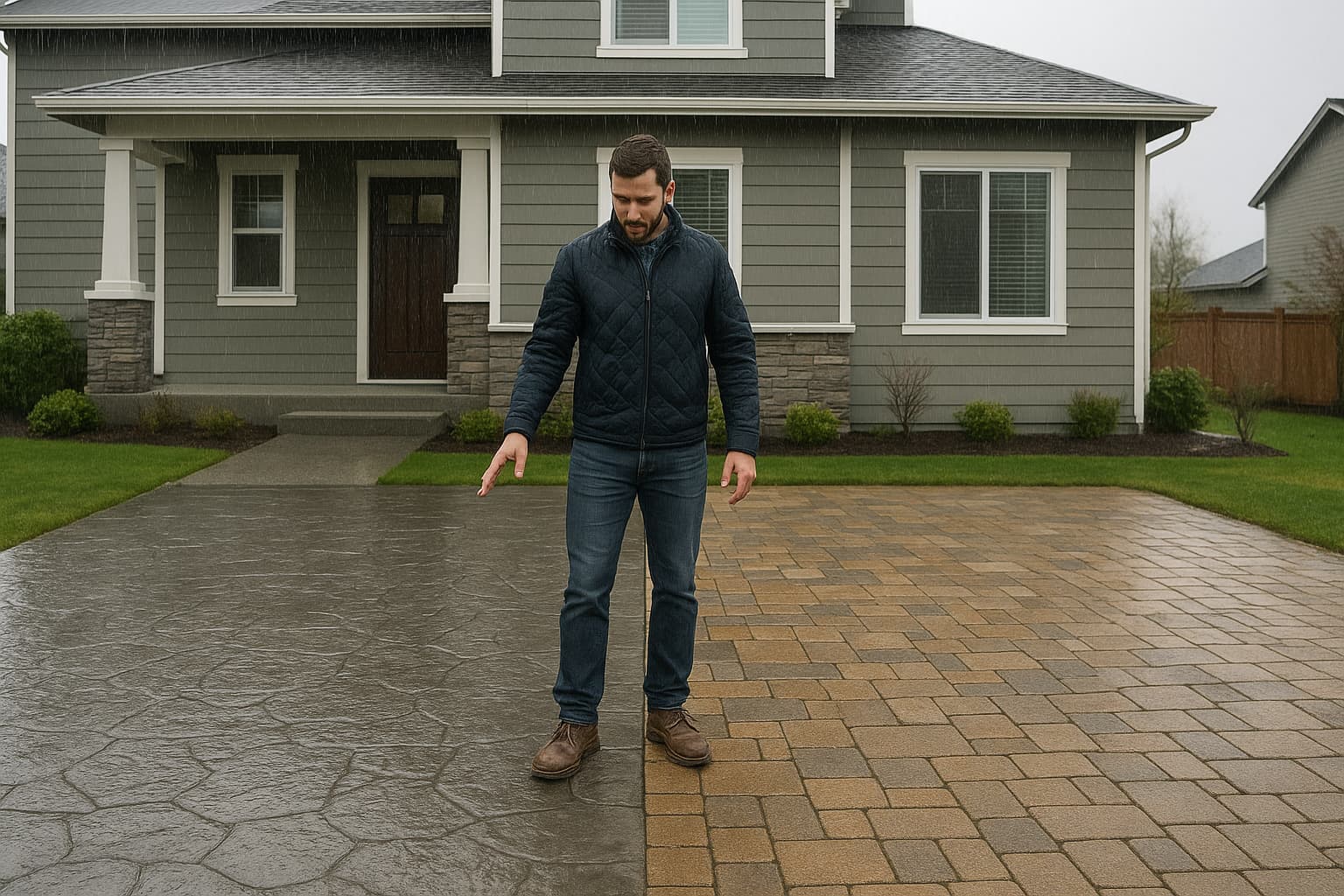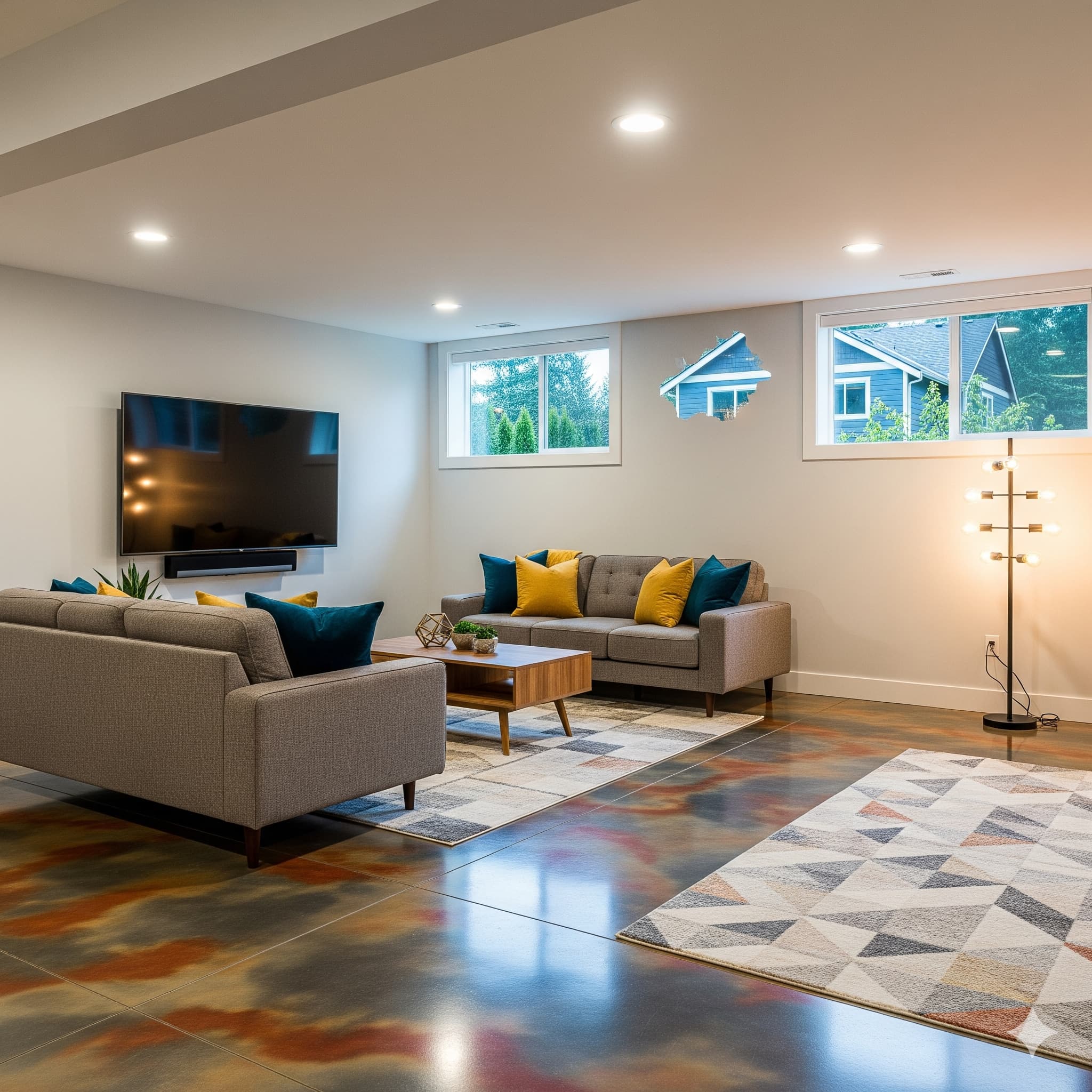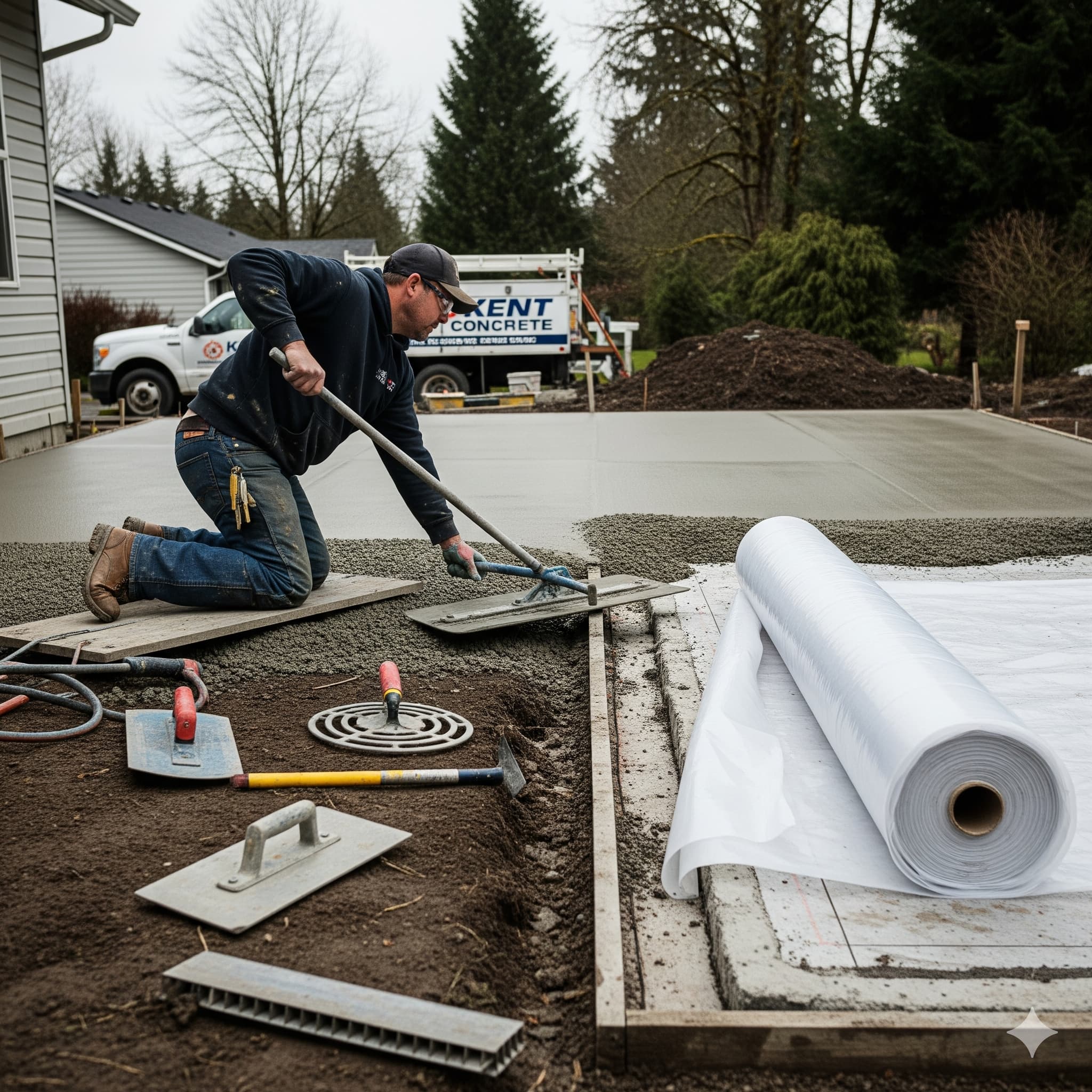
Stamped Concrete vs. Pavers: Best Choice for Kent’s Wet Climate?
Choosing between stamped concrete and pavers for Washington’s challenging wet climate requires understanding how each material performs under the Pacific Northwest’s unique conditions. Both options offer distinct advantages, but their long-term performance, maintenance requirements, and cost considerations differ significantly when subjected to the region’s extended wet seasons and occasional freeze-thaw cycles.
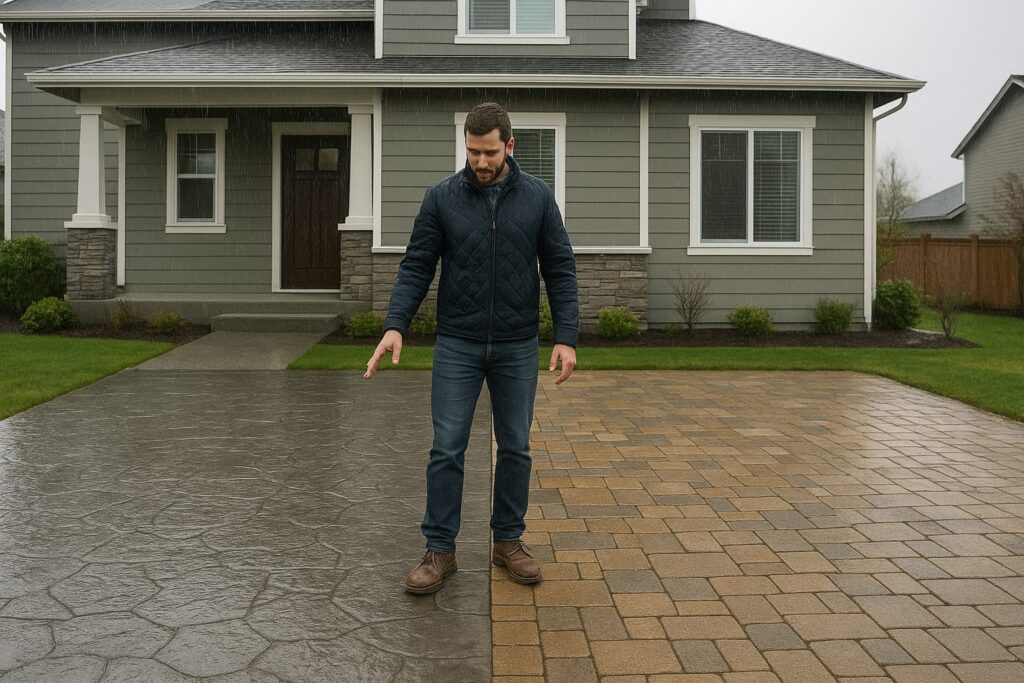
Climate Performance Comparison
Washington’s wet climate creates specific challenges that affect both stamped concrete and paver installations differently. The state’s annual rainfall, averaging 35 to 45 inches in most areas, combined with extended periods of moisture exposure, tests the durability and maintenance requirements of outdoor hardscaping materials.
Stamped concrete performs exceptionally well in wet conditions when properly sealed, as the monolithic surface prevents water infiltration between joints that can cause problems in paver installations. The seamless surface sheds water effectively while resisting the moss and organic growth that thrives in Washington’s humid environment.
Paver systems, while naturally more permeable, can experience challenges with joint material washout, organic growth between pavers, and settling issues when subjected to the region’s soil moisture variations. However, their segmented nature allows individual replacement if damage occurs.
Freeze-thaw resistance varies between the two options, with properly installed stamped concrete typically showing better resistance to winter damage due to its monolithic construction and ability to move as a single unit during soil expansion and contraction cycles.
Moisture Management and Drainage
Drainage performance differs significantly between stamped concrete and pavers in Washington’s wet climate. Properly sloped stamped concrete directs water runoff efficiently, preventing pooling that can lead to staining or surface deterioration during extended wet periods.
Paver installations offer natural permeability through joint spaces, allowing water infiltration that can benefit overall site drainage. However, this permeability can become problematic when joint sand washes out or organic material accumulates, reducing drainage effectiveness.
Surface water management proves easier with stamped concrete due to predictable drainage patterns and reduced maintenance of drainage features. Paver systems require ongoing joint maintenance and occasional re-sanding to maintain optimal drainage performance.
Subsurface drainage considerations favor stamped concrete installations, which can incorporate integrated drainage systems during installation. Paver systems rely more heavily on base preparation and may require additional drainage infrastructure to prevent undermining during Washington’s wet seasons.
Maintenance Requirements in Wet Conditions
Cleaning and maintenance demands vary significantly between the two materials when subjected to Washington’s persistent moisture. Stamped concrete requires periodic pressure washing and sealing, but generally resists organic growth better than paver installations.
Moss and algae control becomes more challenging with pavers due to the numerous joints and surface textures that provide growing environments for organic material. Regular cleaning and preventive treatments prove essential for maintaining appearance in the Pacific Northwest’s humid conditions.
Winter maintenance considerations favor stamped concrete, which typically requires only snow removal and occasional de-icing. Paver installations may experience individual unit movement during freeze-thaw cycles, requiring periodic releveling and joint maintenance.
Long-term maintenance costs generally favor stamped concrete due to lower ongoing care requirements and longer intervals between major maintenance activities. Paver systems often require more frequent attention to maintain optimal appearance and performance.
Durability and Longevity Factors
Service life expectations differ between stamped concrete and pavers when exposed to Washington’s challenging climate conditions. Quality stamped concrete installations typically provide 25 to 30 years of service with proper maintenance, while paver systems may require major maintenance or replacement every 15 to 20 years.
Weather resistance varies between the materials, with stamped concrete generally showing better resistance to the constant moisture exposure and UV degradation that Washington’s climate creates. Quality sealers protect stamped concrete surfaces while maintaining a consistent appearance.
Structural integrity remains more predictable with stamped concrete due to its monolithic nature, while paver systems can experience individual unit movement or settling that affects overall installation integrity over time.
Repair considerations favor pavers for isolated damage, as individual units can be replaced without affecting surrounding areas. However, stamped concrete repairs, while more complex, typically address larger areas more cost-effectively.
Cost Analysis for Washington Installations
Initial installation costs typically favor stamped concrete, ranging from $12 to $18 per square foot compared to $15 to $25 per square foot for quality paver installations. The cost difference becomes more pronounced for larger projects where stamped concrete’s efficiency advantages compound.
Labor considerations affect costs differently in Washington’s wet climate, where weather delays can extend project timelines. Stamped concrete installations typically complete faster, reducing weather-related delays, while paver projects may require extended dry periods for optimal results.
Material costs reflect regional availability and transportation considerations. Stamped concrete materials are readily available throughout Washington, while specialty pavers may require longer lead times and higher transportation costs to remote locations.
Long-term cost considerations often favor stamped concrete due to lower maintenance requirements and longer replacement intervals. However, individual paver replacement costs typically prove lower than stamped concrete repair expenses for localized damage.
Aesthetic Considerations and Design Flexibility
Design options vary significantly between the two materials, with stamped concrete offering virtually unlimited pattern and color possibilities that can replicate natural stone, brick, or custom designs. Modern stamping techniques create realistic textures that complement Washington’s natural aesthetic preferences.
Color retention proves more predictable with quality stamped concrete installations that include UV-resistant sealers. Paver color stability depends on material quality and manufacturing processes, with some options showing better fade resistance than others.
Pattern flexibility allows stamped concrete to accommodate custom designs, logos, or unique layouts that paver systems cannot easily replicate. This advantage proves valuable for commercial applications or unique residential designs.
Integration with landscape features often proves easier with stamped concrete due to its moldable nature during installation. Paver systems require more planning for curves, irregular shapes, or integration with existing hardscape elements.
Installation Considerations for Washington
Weather dependency affects installation timing for both materials, but typically impacts paver installations more significantly due to extended installation periods and requirements for dry base conditions. Stamped concrete can often be installed during brief weather windows.
Seasonal timing becomes critical for both materials, with Washington’s dry summer months providing optimal installation conditions. However, stamped concrete’s faster installation often allows completion during shorter weather windows that might prove insufficient for paver projects.
Site preparation requirements differ between the materials, with both requiring proper excavation and base preparation. However, stamped concrete installation typically involves fewer weather-sensitive steps that can delay project completion.
Access considerations may favor one material over another depending on site conditions. Concrete trucks require direct access for stamped concrete installation, while pavers can be transported manually to areas with limited access.
Professional Installation Benefits
Kent Concrete Masters provides specialized expertise in both stamped concrete and paver installations, offering unbiased recommendations based on specific site conditions, climate exposure, and performance requirements for Washington applications.
Quality control during installation ensures optimal performance regardless of material choice. Professional contractors understand the preparation and installation techniques that maximize durability in Washington’s challenging climate conditions.
Warranty coverage differs between materials and contractors, with established professionals providing comprehensive protection for both material performance and installation quality that supports long-term customer satisfaction.
Local knowledge of Washington’s climate challenges, soil conditions, and permitting requirements ensures installations comply with regional standards while optimizing performance for Pacific Northwest conditions.
Making the Right Choice for Your Project
Site-specific factors, including exposure, drainage, intended use, and aesthetic preference, should guide material selection decisions. Properties with excellent drainage and contemporary design preferences often favor stamped concrete, while traditional designs or areas requiring maximum permeability may benefit from paver installations.
Budget considerations should include both initial installation costs and long-term maintenance expenses. While pavers may offer lower repair costs for isolated damage, stamped concrete typically provides better overall value through reduced maintenance requirements.
Climate exposure assessment helps determine which material better suits specific site conditions. Areas with heavy tree cover or poor air circulation may favor stamped concrete due to its superior resistance to organic growth.
Long-term planning considerations, including potential changes in use, aesthetic preferences, or property improvements, should influence material selection. Stamped concrete offers more flexibility for future modifications, while pavers provide easier partial replacement options.
Both stamped concrete and pavers can perform well in Washington’s wet climate when properly installed and maintained. Understanding the specific advantages and challenges of each material ensures optimal selection for your particular application, climate exposure, and performance requirements in the Pacific Northwest’s demanding environment.

